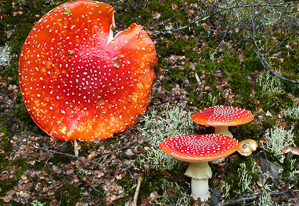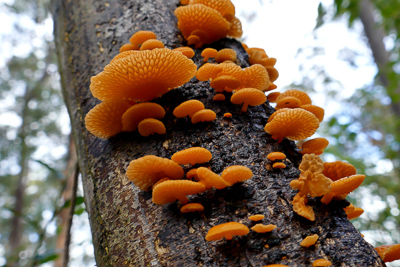Fungal ‘weeds’ have been introduced or hitch-hiked into Australia and many are now well established, spreading from parks and gardens into bushlands. Like plant weeds, these are displacing native Australian fungi that evolved alongside and, in many cases have beneficial symbiotic relationships with, native animals and plants.
The most damaging ‘weed’ species are difficult, if not impossible, to eradicate but we can take action to stop their spread. See below to: Arrive clean | Leave clean.
Two ‘weed’ species that have attractive fruiting bodies and are now very common are the charismatic Fly Agaric (Amanita muscaria) and Orange Pore or Ping Pong Bats (Favolaschia calocera).
Amanita muscaria occurs with Pinus species and has been introduced into pine plantations for its ectomycorrhizal symbiotic benefits. However, it has now switched from this host to the native Myrtle Beech (Nothofagus cunninghamii) and is spreading through temperate forests of Victoria, Tasmania and New Zealand. More recently it has been found in parts of NSW and WA. It has the potential to displace native ectomycorrhizal species but how this may affect the ecology and health of native forests and biodiversity more generally, is not yet known. A. muscaria is poisonous to humans in large doses.
In Australia A. muscaria is often confused with the native Vermilion Grisette (Amanita xanthocephala), which grows in association with eucalypts. A. xanthocephala generally lacks the white warts of A. muscaria and does not have a ring. Download poster: Wanted Amanitas (prepared by Sapphire McMullan-Fisher, Ian Bell and Katrina Syme) to assist in recognising the differences between them. For a higher resolution version of the A3 poster contact Fungimap@gmail.com,
Favolaschia calocera is an introduced, wood-inhabiting saprotrophic fungus that has now significantly expanded its original range in Asia, dominates disturbed habitats and is considered invasive. It is found in Australia from SE Queensland to WA.
Sticky-bun Bolete (Suillus granulatus), Slippery Jack (Suillus luteus) and Mousy or Grey Tricholoma (Tricholoma terreum) are also ectomycorrhizal, introduced from the Northern Hemisphere and now throughout pine plantations in Australia.
Deathcap (Amanita phalloides) appears to be confined to exotic broadleaf, pine and conifer species but is common in parks and gardens in SA, Victoria – including Melbourne – and the ACT. It is extremely toxic (see here for our page on poisonous fungi).
Others (microfungi) cause disease like the Chytrid amphibian fungus (Batrachochytrium dendrobatidis).
According to the 2011 State of the Environment Report:
The chytrid fungus124 has been responsible for mass deaths of frogs worldwide and is widespread in Australia. A significant association between amphibian declines in upland rainforests of northern Queensland and three consecutive years of warm weather125suggests future warming could increase the vulnerability of frogs to the fungus.
Phytophthora cinnamomi is fungus-like but is more closely related to plants than it is fungi. It is responsible for root-rot and is listed as a key threatening processes under the Commonwealth Environment Protection and Biodiversity Conservation Act 1999. It currently affects more than 40 per cent of the native plant species and half of the endangered ones in the south-west of Western Australia where it is destroying much of WA’s Jarrah forests.
Myrtle rust (Austropuccinia psidii) is a disease-causing exotic fungus which threatens around 350 native species like bottle brush (Callistemon spp.), tea tree (Melaleuca spp.) and eucalypts (Eucalyptus spp., Angophora spp., and Corymbia spp.). It can cause deformed leaves, heavy defoliation of branches, reduced fertility, dieback, stunted growth, and plant death. First found in NSW in 2010 it is now established along the east coast of Australia and present in Victoria, mainly at production nurseries and wholesale outlets in and around metropolitan Melbourne. It has recently been discovered in Burnie, Tas and in the Darwin region.
Myrtle rust spores can be spread easily via contaminated clothing, hair, skin and personal items, infected plant material, equipment as well as by insect/animal movement and wind dispersal. These characteristics make it extremely difficult to control and impossible to eradicate from natural settings.
What can be done? Arrive clean. Leave clean!
Humans spread weeds and diseases so it is essential that your shoes, hats and any equipment is thoroughly cleaned before:
- going into bushland sites
- going from one site to another and,
- particularly going from infected sites to non-infected sites
Even your skin and hair, as well as glasses, phones, watches, wallets and other pocket items can carry spores!
See here for Australian Government Dept of the Environment guidelines






